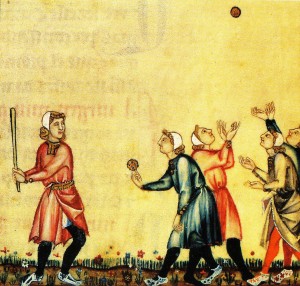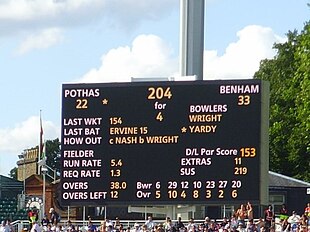
Bowling, in cricket, is the action of propelling the ball toward the wicket defended by a batter. A player skilled at bowling is called a bowler; a bowler who is also a competent batter is known as an all-rounder. Bowling the ball is distinguished from throwing the ball by a strictly specified biomechanical definition, which restricts the angle of extension of the elbow. A single act of bowling the ball towards the batsman is called a ball or a delivery. Bowlers bowl deliveries in sets of six, called an over. Once a bowler has bowled an over, a teammate will bowl an over from the other end of the pitch. The Laws of Cricket govern how a ball must be bowled. If a ball is bowled illegally, an umpire will rule it a no-ball. If a ball is bowled too wide of the striker for the batsman to be able to play at it with a proper cricket shot, the bowler's end umpire will rule it a wide.

Fielding in the sport of cricket is the action of fielders in collecting the ball after it is struck by the striking batter, to limit the number of runs that the striker scores and/or to get a batter out by either catching a hit ball before it bounces, or by running out either batter before they can complete their current run. There are a number of recognised fielding positions and they can be categorised into the offside and leg side of the field. Fielding also involves trying to prevent the ball from making a boundary where four "runs" are awarded for reaching the perimeter and six for crossing it without touching the grass.
In cricket, an umpire is a person who has the authority to make decisions about events on the cricket field according to the Laws of Cricket. Besides making decisions about legality of delivery, appeals for wickets and general conduct of the Game in a legal manner, the umpire also keeps a record of the deliveries and announces the completion of an over.
The Laws of Cricket is a code that specifies the rules of the game of cricket worldwide. The earliest known code was drafted in 1744. Since 1788, the code has been owned and maintained by the private Marylebone Cricket Club (MCC) in Lord's Cricket Ground, London. There are currently 42 Laws, which describe all aspects of how the game is to be played. MCC has re-coded the Laws six times, each with interim revisions that produce more than one edition. The most recent code, the seventh, was released in October 2017; its 3rd edition came into force on 1 October 2022.

The wicket-keeper in the sport of cricket is the player on the fielding side who stands behind the wicket or stumps being watchful of the batsman and ready to take a catch, stump the batsman out and run out a batsman when occasion arises. The wicket-keeper is the only member of the fielding side permitted to wear gloves and external leg guards. The role of the keeper is governed by Law 27 and of the Laws of Cricket.

This is a general glossary of the terminology used in the sport of cricket. Where words in a sentence are also defined elsewhere in this article, they appear in italics. Certain aspects of cricket terminology are explained in more detail in cricket statistics and the naming of fielding positions is explained at fielding (cricket).

In cricket, an over consists of six legal deliveries bowled from one end of a cricket pitch to the player batting at the other end, almost always by a single bowler.

In cricket, a no-ball is a type of illegal delivery to a batter. It is also a type of extra, being the run awarded to the batting team as a consequence of the illegal delivery. For most cricket games, especially amateur, the definition of all forms of no-ball is from the MCC Laws of Cricket.
In cricket, a bye is a type of extra. It is a run scored by the batting team when the ball has not been hit by the batter and the ball has not hit the batter's body.

In cricket, a wide is a type of illegal delivery to a batter that is judged by the umpire to be too wide or too high to be hit by the batsman by means of a normal cricket shot. It is also a type of extra, being the run awarded to the batting team as a consequence of such an illegal delivery.

In cricket, batting is the act or skill of hitting the ball with a bat to score runs and prevent the loss of one's wicket. Any player who is currently batting is, since September 2021, officially referred to as a batter —regardless of whether batting is their particular area of expertise. Batters have to adapt to various conditions when playing on different cricket pitches, especially in different countries; therefore, as well as having outstanding physical batting skills, top-level batters will have quick reflexes, excellent decision-making skills, and be good strategists. Although batsman is still widely used.

In cricket, a dismissal occurs when a batter's innings is brought to an end by the opposing team. Other terms used are the batter being out, the batting side losing a wicket, and the fielding side taking a wicket. The ball becomes dead, and the dismissed batter must leave the field of play for the rest of their team's innings, to be replaced by a team-mate. A team's innings ends if ten of the eleven team members are dismissed. Players bat in pairs so, when only one batter remains who can be not out, it is not possible for the team to bat any longer. This is known as dismissing or bowling out the batting team, who are said to be all out.

In cricket, a run is the unit of scoring. The team with the most runs wins in many versions of the game, and always draws at worst, except for some results decided by the DLS method, which is used in rain-shortened limited-overs games when the two teams have had a different number of opportunities to score runs.
Baseball and cricket are the best-known members of a family of related bat-and-ball games. Both have fields that are 400 feet (120 m) or more in diameter between their furthest endpoints, offensive players who can hit a thrown/"bowled" ball out of the field and run between safe areas to score runs (points) at the risk of being gotten out, and have a major game format lasting about 3 hours.
Law 41 of the Laws of Cricket covers unfair play. This law has developed and expanded over time as various incidents of real life unfair play have been legislated against.

In cricket, a scorer is someone appointed to record all runs scored, all wickets taken and, where appropriate, the number of overs bowled. In professional games, in compliance with Law 3 of the Laws of Cricket, two scorers are appointed, most often one provided by each team.

A delivery or ball in cricket is a single action of bowling a cricket ball toward the batter. Once the ball has been delivered, batters may attempt to score runs, with the bowler and other fielders attempting to stop this by getting the batters out. When the ball becomes dead, the next delivery can begin.
Armchair cricket is a card game that is inspired by the bat and ball sport cricket. It is played by either two or four people. Depending on the version of the game being played, a game can last a few minutes to several hours. It was produced commercially in England but is no longer made.

Bat-and-ball games are field games played by two opposing teams. Action starts when the defending team throws a ball at a dedicated player of the attacking team, who tries to hit it with a bat and run between various safe areas in the field to score runs (points). The defending team can use the ball in various ways against the attacking team's players to force them off the field when they are not in safe zones, and thus prevent them from further scoring. The best known modern bat-and-ball games are cricket and baseball, with common roots in the 18th-century games played in England.

Cricket is a bat-and-ball game that is played between two teams of eleven players on a field at the centre of which is a 22-yard (20-metre) pitch with a wicket at each end, each comprising two bails balanced on three stumps. Two players from the batting team stand in front of either wicket, with one player from the fielding team bowling the ball towards the striker's wicket from the opposite end of the pitch. The striker's goal is to hit the bowled ball and then switch places with the nonstriker, with the batting team scoring one run for each exchange. Runs are also scored when the ball reaches or crosses the boundary of the field or when the ball is bowled illegally.













